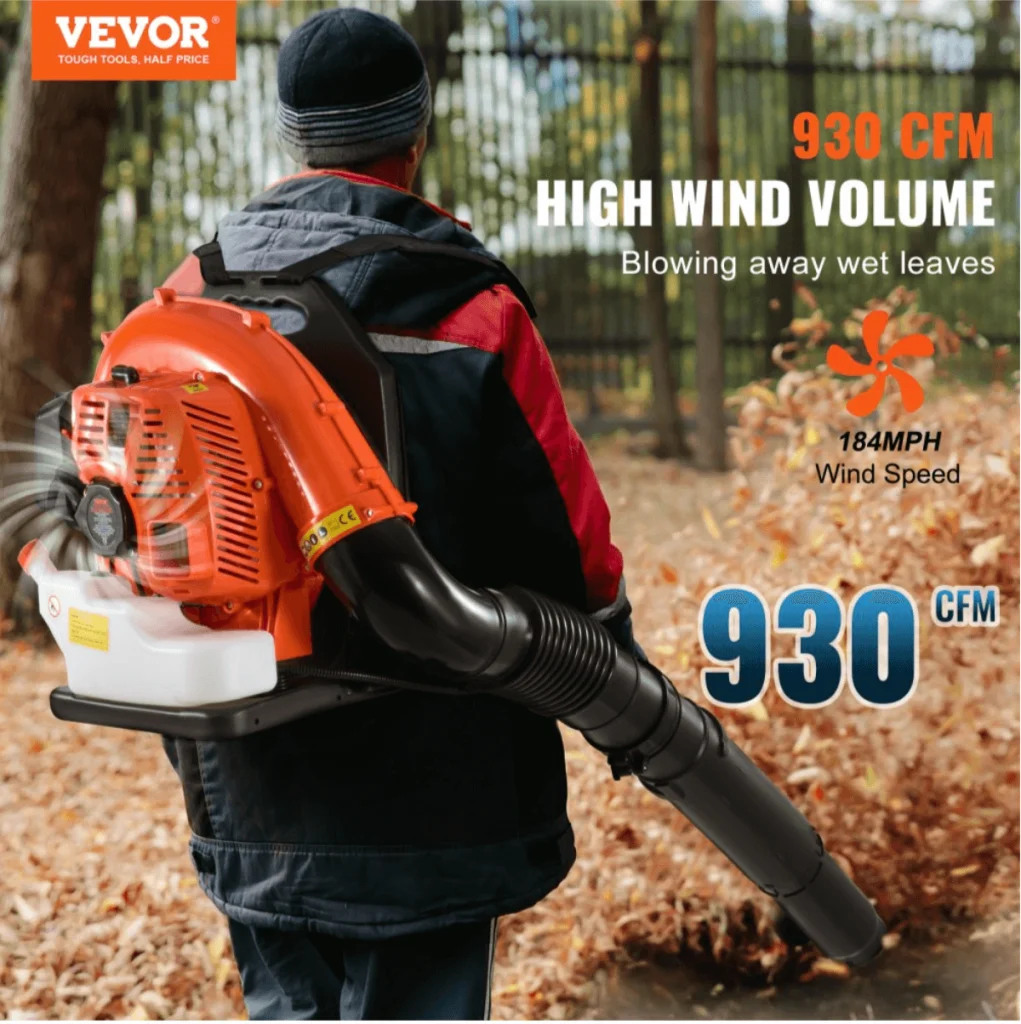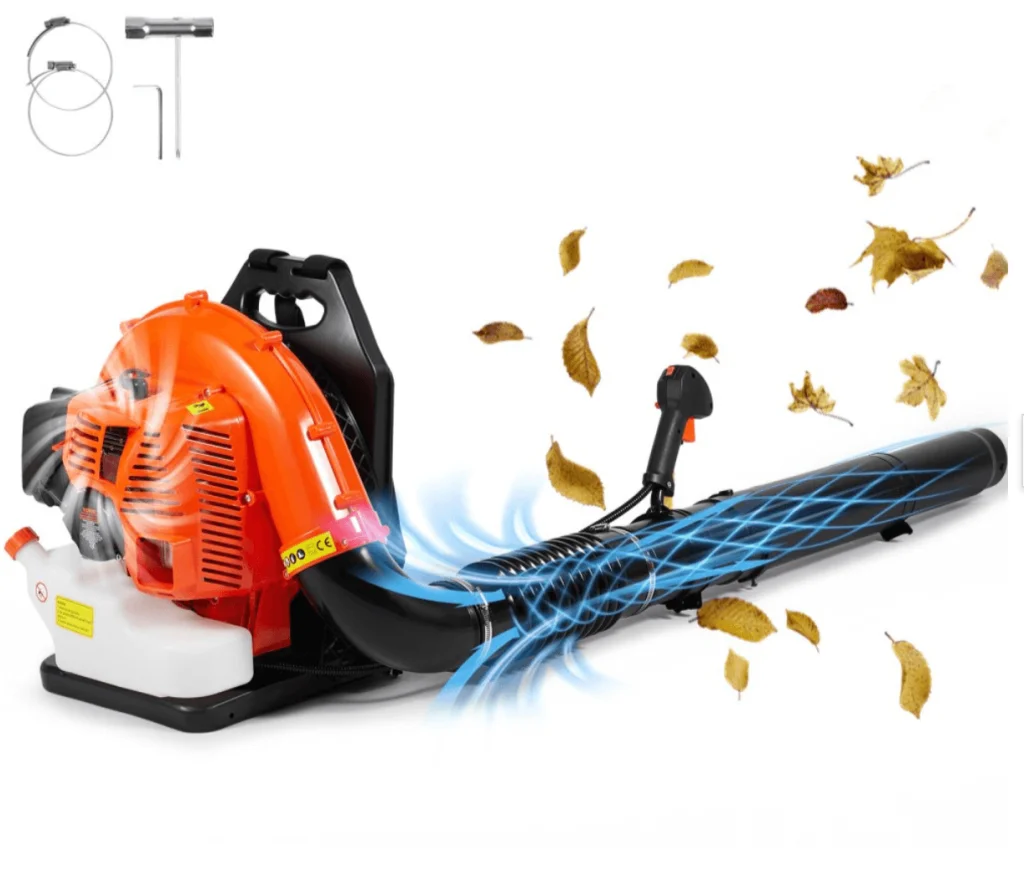You need to blow the leaves in your yard and this requires you to possess a good leaf blower. Still, there are so many models and features out there, which is why it is important to know what works best when it comes to a leaf blower.
Another factor is referred to as the capacity, known as Cubic Feet per Minute or CFM. CFM is one of the most important specifications because it shows the amount of air that a particular model of the leaf blower can move and therefore its efficiency.
This guide provides an overview of everything you should be aware of with regard to CFM, ranging from how it operates, its significance, and how you can select the right CFM. We will also focus more on VEVOR leaf blowers since they are recognized for having high quality and high performance.
Table of contents
What is CFM on Leaf Blower?
Definition of CFM
What is the meaning of the term ‘CFM leaf blower’? The measurements used for the quantitative value of the two products that were compared are different; CFM refers to Cubic Feet per minute, which basically measures the amount of air the blower can push out.
This shows how many cubic feet of air is circulating within the blower per minute. This measurement is important as it determines the effectiveness of the machine in the blowing off of leaves and debris from the yard.
When reading the back or in front of a leaf blower you may come across the term CFM, which means that the blower is capable of moving a large volume of air within a short span.
This is especially so when you have to sweep a big compound or when the leaves that you are collecting from big heaps. The more the number of CFM, the more powerful the leaf blower and the better it will be in doing the required job.
How CFM Affects Leaf Blower Performance
CFM plays a major role in determining how effective a given leaf blower is. For instance, when you are working on a large yard with many trees, the more CFM a leaf blower has, the easier and faster it will take to complete the task.
If your yard is small, and you often handle light and dry leaves, then the relatively lower CFM should suffice.
CFM vs. MPH: Which One Matters More?
When shopping for a leaf blower, you’ll often see two key measurements: Meaning of CFM and Meanings of MPH (Miles Per Hour). Whereas CFM determines the amount of air, MPH determines the rate of air coming out from the blower. It is both, however, the two have different roles aimed at different objectives.
CFM is more critical for moving large amounts of debris, while MPH is essential for lifting and pushing leaves. If you need to clear heavy, wet debris, a higher CFM is more beneficial. For light leaves, a higher MPH can be more effective. Ultimately, the best leaf blower will have a good balance of both CFM and MPH to handle various tasks.
What Does CFM Mean on a Leaf Blower?
The Science Behind CFM Measurement
The volume of air supplied by a blower depends on the inlet size of the blower. The rate at which the blower’s fan turns, which is stated in cubic feet per minute or CFM. As simple as it can get, it is a value of how many cubic feet of air per minute the blower can move. Proper reading of the CFM is a critical factor in the determination of the efficiency and capacity of the blower.
Typically, reference measurements of CFM are made by placing the blower in a specified sealed chamber whose volume is measured and the amount of air circulated in a one-minute time is calculated. This gives a clear indication of the ability as well as efficiency of the blower in question as well.
Industry Standards for CFM
It is important here to note that there are different models of the leaf blowers, classified in different ways with regard to CFM ratings.
For instance:
- Handheld leaf blowers come with a CFM range of 200-400 hence suitable in most light landscaping tasks.
- Suitable for more intensive uses, the backpack blowers deliver an output of between 400 – 700 CFM.
- Portable commercial and industrial blower vacs may be as much as 700 or above in the case of high-duty operations.
The manufacturers of leaf blower VEVOR assure that their products meet and where possible exceed generally established market standards in regard to their capacity, which stands for the CFM rating.
Whether one has a small yard or a large yard, the property owner will be able to find the right CFM blower at VEVOR to get the job done as fast as possible.
What is a Good CFM for a leaf blower?
Ideal CFM Range for Different Types of Jobs
The ideal CFM for your leaf blower depends on the type of job you need to do. For light yard work, such as clearing dry leaves from a small lawn or driveway, a blower with 200-400 CFM should be sufficient. These models are lightweight and easy to handle, making them perfect for quick, everyday tasks.
For more substantial jobs, like clearing wet leaves or large piles of debris, you’ll want a blower with 400-700 CFM. These models can handle tougher tasks and are often equipped with more powerful engines.
If you’re dealing with commercial or industrial-scale jobs, where you need to move large amounts of debris quickly, look for blowers with a CFM rating of 700 or more. These are typically backpack or wheeled models designed for maximum power and efficiency.
CFM for Cordless vs. Corded Leaf Blowers
Both cordless and corded models have their advantages, and the CFM of the two types can also vary. Corded leaf blowers usually provide a higher CFM because they are plugged into wall sockets and can therefore generate more airflow. These are suitable for jobs that require consistent power and there is no concern about the battery power.
In contrast to corded leaf blowers, cordless leaf blowers require greater flexibility and comfort to use. Although their CFM may not be as high as that of certain corded blowers, contemporary cordless blowers nonetheless have a respectable CFM thanks to continuous advancements in battery technology.
How to Calculate CFM for a Leaf Blower
Step-by-Step Guide to Calculating CFM
Calculating the CFM of a leaf blower is straightforward if you have the right tools. Here’s a simple guide:
- Measure the Airflow: Use an anemometer to measure the air velocity at the blower’s nozzle.
- Determine the Nozzle Area: Measure the diameter of the blower’s nozzle and calculate the area.
- Calculate CFM: Calculate the CFM as needed.

For instance, in case your blower offers an air velocity of 120 MPH when converted to feet per minute and a nozzle area of 0. For instance, if the unit area was 1 square foot, the CFM would equal the product of the two values.
Common Mistakes to Avoid
When calculating or interpreting CFM, it’s essential to avoid common errors. One mistake is confusing CFM with MPH, leading to incorrect conclusions about a blower’s power. Another common mistake is not considering the blower’s overall design and how it might affect airflow.
Always ensure your measurements are accurate and taken under consistent conditions. This will give you a true representation of the blower’s performance.
Recommended For Your Project
VEVOR Leaf Blower Review
Overview of VEVOR Leaf Blowers
VEVOR is a popular company that provides numerous tools, and the leaf blowers that they sell are quite good as well. VEVOR brand is specifically designed for homeowners and for professionals, and they bring the following features to help make yard work easier and faster.

From handheld walk-behinds to professional backpack blowers, VEVOR has a product for every job type.
In-Depth Look at VEVOR’s CFM Ratings
Furthermore, VEVOR’s brands of the blower are famous for their high CFM (Cubic Feet per Minute) which is essential in maintaining yard work. For instance, the 79CC backpack model provides as high as 930 CFM airflow.
This high CFM rating means the blower can move a substantial volume of air, making it exceptionally effective at clearing large areas of debris, including wet leaves, sand, gravel, and even light snow.

Such power is particularly beneficial for extensive properties and heavy-duty tasks, where a robust airflow can significantly speed up the cleanup process. Moreover, VEVOR has higher CFM standards for their blowers meaning they will perform well in all the tasks whether in a home garden or in landscaping.
By offering strong airflow capabilities, VEVOR’s leaf blowers provide both efficiency and versatility, allowing users to tackle a wide range of outdoor maintenance challenges with ease.
Frequently Asked Questions
What is CFM for leaf blowers?
CFM means Cubic Feet per minute and is the amount of air movement a leaf blower can create. This is an important parameter in predicting how well the blower would perform when blowing leaves or debris.
How important is CFM in a leaf blower?
CFM is very significant since it impacts on the capacity of the blower to stage high levels of debris. Higher CFM normally implies high performance, particularly when it comes to the heavy tasks.
Can I improve the CFM of my leaf blower?
One thing you cannot do is alter the CFM rating of your leaf blower, but proper maintenance can help it work at its optimum. Some of the ways that can enhance the performance of the blower include; cleaning the air filters often, maintaining the motor and ensuring that the right procedure is followed while operating the blower.
Summary
Knowledge of CFM is crucial for selecting an appropriate leaf blower that will provide the best results. CFM quantifies the volume of the air a blower can handle at a given time and is a predictor of the machine’s efficiency and power. Whether you’re using the blower for a simple task like blowing leaves in the yard or cleaning driveways, choosing a model with the right CFM is important.
When it comes to power, VEVOR has a range of leaf blowers that come with an impressive CFM for different models. When it comes to making the choice and maintaining the appearance of your yard, knowing the significance of CFM will assist you in this process.





